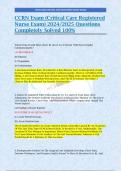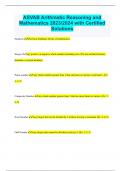CCRN EXAM (CRITICAL CARE REGISTERED NURSE EXAM)
CCRN Exam (Critical Care Registered
Nurse Exam) 2024/2025 Questions
Completely Solved 100%
Which Drug Would Most Likely Be Given To A Patient With Hypertrophic
Cardiomyopathy?
(A) METOPROLOL
(B) Digoxin
(C) Dopamine
(D) Dobutamine
A Decrease In Heart Rate, Provided By A Beta Blocker Such As Metoprolol, Would
Increase Filling Time. In Hypertrophic Cardiomyopathy, There Is A Problem With
Filling. A Decrease In Heart Rate Would Increase Filling Time. Diastolic Dysfunction
Does Not Cause A Problem With Ejection, And The Ef Is Normal. The Other 3
Choices May Be Indicated For Systolic Dysfunction.
A Patient Is Admitted With St Elevation In V2, V3, And V4. Four Days After
Admission, The Patient Suddenly Developed A Holosystolic Murmur At The Lower
Left Sternal Border, Chest Pain, And Hypotension. What Complication Should The
Nurse Expect?
(A) Papillary Muscle Rupture
(B) VENTRICULAR SEPTAL DEFECT
(C) Acute Mitral Stenosis
(D) Acute Reinfarction
The Scenario Describes An Acute Anterior Stemi, Generally Caused By An Occlusion
Of The Lad. This Type Of Mi Is Most Likely To Result In A Vsd. Additionally, The
Location Of The Murmur Is Important. Mitral Valve Disease-Related Problems Do
Not Cause Murmurs To Be Loudest At The Left Sternal Border, Whereas A Vsd
Would Result In A Murmur At This Location.
A Postoperative Patient On The Surgical Unit Suddenly Develops Chest Pain,
Extreme Weakness, And Dyspnea And Is Found To Have St Elevation In Ii, Iii, And
, CCRN EXAM (CRITICAL CARE REGISTERED NURSE EXAM)
AVF On The Stat Ekg. B/P Is 92/62, Heart Rate 58, Respiratory Rate 28, Lungs Are
Clear, And Heart Sound Assessment Reveals An S4, No Murmurs. In Addition To
Preparing The Patient For Pci, Which Of The Following Interventions Would You
Anticipate?
(A) Nitroglycerin Drip, Aspirin
(B) Furosemide, Atropine
(C) Transcutaneous Pacing, Morphine
(D) AGGRESSIVE FLUID ADMINISTRATION, RIGHT-SIDED EKG.
The Scenario Describes A Patient Having An Acute Inferior Stemi, Generally Due To
Rca Occlusion. An Rca Occlusion May Result In Rv Infarct, Which This Patient Has
Signs Of (Hypotension With Clear Lungs). The Definitive Treatment Is Emergent Pci.
Fluid Administration Will Help Increase Coronary Artery Perfusion By Correcting
Hypotension And Ensure Adequate Rv Preload. The Right-Sided Ekg May Help
Confirm The Rv Infarct. Nitroglycerin, Diuretics, And Morphine May Decrease
Preload, Which Would Worsen Hypotension.
A 52 Year Old Male Presents With Complaints Of Blurred Vision And Shortness Of
Breath. B/P Is 232/136, Heart Rate 102, Respiratory Rate 28 With Crackles In Lower
Lung Fields Bilaterally, With S3 And S4 Heart Sounds On Auscultation. Which Of The
Following Would Be Indicated For This Patient?
(A) NITROPRUSSIDE DRIP, ADMIT TO CRITICAL CARE UNIT
(B) Digoxin, Furosemide
(C) Labetalol Drip, Admit To A Medical Unit
(D) Lisinopril, Calcium Channel Blocker
The Patient Has Signs Of Organ Dysfunction (Heart Failure) Secondary To Extreme
Hypertension. Therefore, He Has Hypertension Crisis Or Emergency. The B/P Needs
To Be Emergently Decreased. Most Often This Treatment Is Best Done In An Icu.
An 80 Year Old Female Presents With Chief Complaint Of Acute Shortness Of
Breath. Clinical Exam Reveals B/P 182/102, Heart Rate 105/Minute, Respiratory Rate
32/Minute, Lungs With Crackles Bilaterally, Pulse Oximetry Of 88%, S4 On
Auscultation. Ekg Revealed Sinus Tachycardia, Left Ventricular Hypertrophy Pattern,
Chest Radiograph Showed Normal Heart Size, Pulmonary Vascular Congestion, And
Echocardiogram Showed Ef Of 55%. Which Of The Following Should Be Avoided In
This Patient's Treatment Plan?
(A) Calcium Channel Blocker
(B) DIGOXIN
, CCRN EXAM (CRITICAL CARE REGISTERED NURSE EXAM)
(C) Low-Dose Diuretics
(D) Oxygen
The Patient Presents With Signs Of Heart Failure Due To Diastolic Dysfunction
(Hypertension, Left Ventricular Hypertrophy, Ef > 40%). These Patients Have A
Problem With Filling, Not Ejecting. Digoxin, A Positive Inotrope, May Increase Wall
Stress And Worsen Filling Of The Left Ventricle.
Mrs. Jones Has Heart Failure. Despite Optimal Therapy, She Gets Short Of Breath
When She Gets Up To Walk To The Bathroom. Which Of The Following Is The Patient
Experiencing Regarding Heart Failure?
(A) Nyha Class I Heart Failure, May Benefit From An Icd
(B) Nyha Class Ii Heart Failure, May Benefit From An Icd
(C) NYHA CLASS III HEART FAILURE, MAY BENEFIT FROM AN ICD
(D) Heart Failure Cannot Be Classified, Further Information Is Needed
The Patient Has Symptoms With Minimal Activity, Which Describes Nyha Class Iii.
This Would Qualify Her For An Icd.
When The Above Patient, Mrs. Jones, Has An Exacerbation Of Her Heart Failure
(Class Iii), She Develops Jugular Venous Distention (Jvd), Peripheral Edema, And
Abdominal Discomfort. These Are Clinical Signs Specific To:
(A) Acute Left Ventricular Failure
(B) CHRONIC RIGHT VENTRICULAR FAILURE
(C) Acute Right Ventricular Failure
(D) Chronic Dehydration
The Signs Described Are Those Of Chronic Right-Sided Heart Failure. Acute Right
Ventricular Failure May Result In Jvd But Not Peripheral Edema Or Abdominal
Discomfort (Which Is Due To Liver Engorgement).
The Nurse Managing A Post-Op Cabg Patient Assesses A Sudden Drop In B/P,
Distended Neck Veins, Muffled Heart Tones, Minimal Chest Tube Of Output, And A
Systolic Pressure That Fluctuates With Breathing Pattern. The Patient Most Likely
Needs:
(A) EMERGENT RETURN TO THE OR
(B) Clamping Of The Chest Tube





